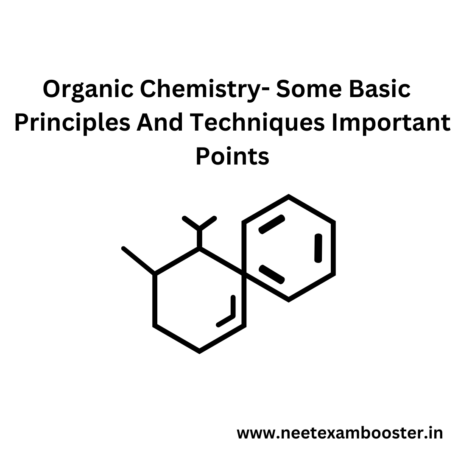Organic chemistry : Some basic principles and processes Important points :Organic chemistry is study of carbon-based compounds, which can be classified into functional groups. Organic reactions can be catalyzed by the enzymes, metals, acids, and bases and involve substitution, elimination, addition, and rearrangement.
Organic synthesis involves preparation of the organic compounds using techniques such as distillation, extraction, chromatography, and crystallization. Spectroscopic techniques such as NMR, IR, and mass spectrometry are used to identify and characterize the organic compounds.
Organic compounds can exist as different isomers, including the structural isomers, stereoisomers, and enantiomers. Organic reactions can include the electrophilic addition, nucleophilic substitution, and free-radical reactions. Organic compounds can also undergo oxidation and reduction reactions.
Organic chemistry : Some basic principles and processes Important points, Organic chemistry : Some basic principles and processes Important points, Organic chemistry : Some basic principles and processes Important points, Organic chemistry : Some basic principles and processes Important points,

NCERT Chemistry Class 11 Chapter 12- Organic chemistry : Some basic principles and processes 25 Important points
There are 25 important points on organic chemistry – some basic principles and techniques
- Organic chemistry is study of carbon-based compounds.
- Carbon is unique in its ability to form a long chain of molecules due to its ability to form four covalent bonds.
- Organic molecules can be classified into different functional groups, which are groups of atoms that give the molecule its characteristic properties and their reactivity.
- The most common functional groups includes alcohols, aldehydes, ketones, carboxylic acids, esters, and amines.
- Organic reactions can be classified into several categories, including substitution, elimination, addition, and the rearrangement.
- Organic reactions can be catalyzed by the enzymes, metals, acids, and bases.
- Organic synthesis involves preparation of organic compounds from simpler starting materials.
- The most common techniques used in the organic synthesis include distillation, extraction, chromatography, and crystallization.
- Distillation is used to separate and purify the organic compounds based on differences in boiling points.
- Extraction is used to separate and purify the organic compounds based on differences in solubility.
- Chromatography is a separation technique based on the differences in polarity and adsorption.
- Crystallization is used to purify tu organic compounds by allowing them to form crystals.
- NMR spectroscopy is a powerful technique used to identify and characterize the organic compounds.
- Infrared spectroscopy is used to identify the functional groups in organic compounds.
- Mass spectrometry is used to determine molecular weight of organic compounds.
- Organic compounds can exist as different isomers, including the structural isomers, stereoisomers, and enantiomers.
- Structural isomers have same molecular formula but differ in their arrangement of atoms.
- Stereoisomers have same molecular formula and the same arrangement of atoms but differ in their spatial orientation.
- Enantiomers are mirror images of each other and have same physical properties but different biological activities.
- Organic compounds can exhibit in different types of reactions, including electrophilic addition, nucleophilic substitution, and free-radical reactions.
- Electrophilic addition involves addition of an electrophile to a double or triple bond.
- Nucleophilic substitution involves
substitution of a leaving group with a nucleophile. - Free-radical reactions involves formation and reaction of free radicals.
- Organic compounds can undergo the oxidation and reduction reactions.
- Oxidation involves loss of electrons, while reduction involves the gain of electrons.
Some Important Questions From Biology Class 11
| Chapter Name | Quiz Link |
| The Living World | Play Now |
| Biological Classification | Play Now |
| Plant Kingdom | Play Now |
| Animal Kingdom | Play Now |
| Morphology of flowering plants | Play Now |
| Anatomy of flowering plants | Play Now |
| Cell: the unit of life | Play Now |
| Biomolecules | Play Now |
| Cell Cycle and cell division | Play Now |
| Transport in Plants | Play Now |
| Structural organisation in Animals | Play Now |
| Mineral nutrition | Play Now |
| Photosynthesis in higher plants | Play Now |
| Respiration in plants | Play Now |
| Plant Growth and development | Play Now |
| Digestion and Absorption | Play Now |
| Breathing and Exchange of Gases | Play Now |
| Body fluids and circulation | Play Now |
| Excretory products and their elimination | Play Now |
| Locomotion and Movement | Play Now |
| Neural Control and Coordination | Play Now |
| Chemical Coordination and Integration | Play Now |
Some Important Questions From Biology Class 12
| Chapter Name | Quiz Link |
| Reproduction in organism | Play Now |
| Sexual reproduction in flowering plant | Play Now |
| Human reproduction | Play Now |
| Reproductive health | Play Now |
| Principles of inheritance and variation | Play Now |
| Molecular basis of inheritance | Play Now |
| Evolution | Play Now |
| Human health and disease | Play Now |
| Strategies for enhancement in food product | Play Now |
| Microbes in human welfare | Play Now |
| Biotechnology principles and processes | Play Now |
| Biotechnology and its application | Play Now |
| Organism and population | Play Now |
| Ecosystem | Play Now |
| Biodiversity and its conservation | Play Now |
| Environment issue | Play Now |





 155 out of 200 questions were directly asked from these notes in NEET 2024
155 out of 200 questions were directly asked from these notes in NEET 2024
